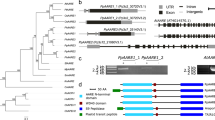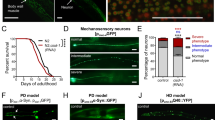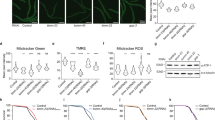Abstract
Degradation of damaged proteins by members of the protein quality control system is of fundamental importance in maintaining cellular homeostasis. In mitochondria, organelles which both generate and are targets of reactive oxygen species (ROS), a number of membrane bound and soluble proteases are essential components of this system. Here we describe the regulation of Podospora anserina LON (PaLON) levels, an AAA+ family serine protease localized in the matrix fraction of mitochondria. Constitutive overexpression of PaLon results in transgenic strains of the fungal ageing model P. anserina showing increased ATP-dependent serine protease activity. These strains display lower levels of carbonylated (aconitase) and carboxymethylated proteins, reduced secretion of hydrogen peroxide and a higher resistance against exogenous oxidative stress. Moreover, they are characterized by an extended lifespan without impairment of vital functions such as respiration, growth and fertility. The reported genetic manipulation proved to be a successful intervention in organismal ageing and it led to an increase in the healthy lifespan, the healthspan, of P. anserina.
This is a preview of subscription content, access via your institution
Access options
Subscribe to this journal
Receive 12 print issues and online access
$209.00 per year
only $17.42 per issue
Buy this article
- Purchase on Springer Link
- Instant access to full article PDF
Prices may be subject to local taxes which are calculated during checkout




Similar content being viewed by others
Change history
21 December 2011
In the version of this letter initially published online and in print, the order of inserts in Fig. 3d had been inverted and the picture in Fig. 4e was not that of a juvenile hypha from the PaLon_Ox1 strain. These errors have been corrected in the HTML and PDF versions of the article.
References
Osiewacz, H. D. & Hermanns, J. The role of mitochondrial DNA rearrangements in aging and human diseases. Aging (Milano.) 4, 273–286 (1992).
Wallace, D. C. A mitochondrial paradigm of metabolic and degenerative diseases, aging, and cancer: a dawn for evolutionary medicine. Annu. Rev. Genet. 39, 359–407 (2005).
Harman, D. Aging: a theory based on free radical and radiation chemistry. J. Gerontol. 11, 298–300 (1956).
Finkel, T. & Holbrook, N. J. Oxidants, oxidative stress and the biology of ageing. Nature 408, 239–247 (2000).
Gredilla, R., Grief, J. & Osiewacz, H. D. Mitochondrial free radical generation and lifespan control in the fungal aging model Podospora anserina. Exp. Gerontol. 41, 439–447 (2006).
Schriner, S. E. et al. Extension of murine life span by overexpression of catalase targeted to mitochondria. Science 308, 1909–1911 (2005).
Lu, B. et al. Roles for the human ATP-dependent Lon protease in mitochondrial DNA maintenance. J. Biol. Chem. 282, 17363–17374 (2007).
Suzuki, C. K., Suda, K., Wang, N. & Schatz, G. Requirement for the yeast gene LON in intramitochondrial proteolysis and maintenance of respiration. Science 264, 891 (1994).
Bota, D. A., Ngo, J. K. & Davies, K. J. Downregulation of the human Lon protease impairs mitochondrial structure and function and causes cell death. Free Radic. Biol. Med. 38, 665–677 (2005).
Osiewacz, H. D. Genes, mitochondria and aging in filamentous fungi. Ageing Res. Rev. 1, 425–442 (2002).
Bulteau, A. L., Szweda, L. I. & Friguet, B. Mitochondrial protein oxidation and degradation in response to oxidative stress and aging. Exp. Gerontol. 41, 653–657 (2006).
Osiewacz, H. D., Skaletz, A. & Esser, K. Integrative transformation of the ascomycete Podospora anserina: identification of the mating-type locus on chromosome VII of electrophoretically separated chromosomes. Appl. Microbiol. Biotechnol. 35, 38–45 (1991).
Scheckhuber, C. Q. et al. Reducing mitochondrial fission results in increased life span and fitness of two fungal ageing models. Nature Cell Biol. 9, 99–105 (2007).
Ikeda, K. et al. N (epsilon)-(carboxymethyl)lysine protein adduct is a major immunological epitope in proteins modified with advanced glycation end products of the Maillard reaction. Biochemistry 35, 8075–8083 (1996).
Bakala, H. et al. Changes in rat liver mitochondria with aging. Lon protease-like reactivity and N(epsilon)-carboxymethyllysine accumulation in the matrix. Eur. J. Biochem. 270, 2295–2302 (2003).
Bota, D. A. & Davies, K. J. Lon protease preferentially degrades oxidized mitochondrial aconitase by an ATP-stimulated mechanism. Nature Cell Biol. 4, 674–680 (2002).
Reverter-Branch, Cabiscol, E., Tamarit, J. & Ros, J. Oxidative damage to specific proteins in replicative and chronological-aged Saccharomyces cerevisiae: common targets and prevention by calorie restriction. J. Biol. Chem. 279, 31983–31989 (2004).
Scheckhuber, C. Q., Rödel, E. & Wüstehube, J. Regulation of mitochondrial dynamics--characterization of fusion and fission genes in the ascomycete Podospora anserina. Biotechnol. J. 3, 781–790 (2008).
Osiewacz, H. D. & Borghouts, C. Mitochondrial oxidative stress and aging in the filamentous fungus Podospora anserina. Ann. NYAcad. Sci. 908, 31–39 (2000).
Borghouts, C., Kimpel, E. & Osiewacz, H. D. Mitochondrial DNA rearrangements of Podospora anserina are under the control of the nuclear gene grisea. Proc. Natl. Acad. Sci. U SA 94, 10768–10773 (1997).
Dufour, E., Boulay, J., Rincheval, V. & Sainsard-Chanet, A. A causal link between respiration and senescence in Podospora anserina. Proc. Natl. Acad. Sci. USA 97, 4138–4143 (2000).
Stumpferl, S. W., Stephan, O. & Osiewacz, H. D. Impact of a disruption of a pathway delivering copper to mitochondria on Podospora anserina metabolism and life span. Eukaryot. Cell 3, 200–211 (2004).
van Dyck L., Neupert, W. & Langer, T. The ATP-dependent PIM1 protease is required for the expression of intron-containing genes in mitochondria. Genes Dev. 12, 1515–1524 (1998).
Esser, K. Podospora anserina. Handbook of Genetics (ed. R. C. King) 531–551 (Plenum Press, 1974).
Kück, U. et al. The onset of senescence is affected by DNA rearrangements of a discontinuous mitochondrial gene in Podospora anserina. Curr. Genet. 9, 373–382 (1985).
Kunstmann, B. & Osiewacz, H. D. Over-expression of an S-adenosylmethionine-dependent methyltransferase leads to an extended lifespan of Podospora anserina without impairments in vital functions. Aging Cell 7, 651–662 (2008).
Hamann, A., Krause, K., Werner, A. & Osiewacz, H. D. A two-step protocol for efficient deletion of genes in the filamentous ascomycete Podospora anserina. Curr. Genet. 48, 270–275 (2005).
Chaveroche, M. K., Ghigo, J. M. & d'Enfert, C. A rapid method for efficient gene replacement in the filamentous fungus Aspergillus nidulans. Nucleic Acids Res. 28, E97 (2000).
Osiewacz, H. D. A versatile shuttle cosmid vector for the efficient construction of genomic libraries and for the cloning of fungal genes. Curr. Genet. 26, 87–90 (1994).
Pfaffl, M. W. A new mathematical model for relative quantification in real-time RT-PCR. Nucleic Acids Res. 29, e45 (2001).
Borghouts, C., Werner, A., Elthon, T. & Osiewacz, H. D. Copper-modulated gene expression and senescence in the filamentous fungus Podospora anserina. Mol. Cell Biol. 21, 390–399 (2001).
Levine, R. L., Williams, J. A., Stadtman, E. R. & Shacter, E. Carbonyl assays for determination of oxidatively modified proteins. Methods Enzymol. 233, 346–357 (1994).
Nulton-Persson, A. C. & Szweda, L. I. Modulation of mitochondrial function by hydrogen peroxide. J. Biol. Chem. 276, 23357–23361 (2001).
Hamann, A., Brust, D. & Osiewacz, H. D. Deletion of putative apoptosis factors leads to lifespan extension in the fungal ageing model Podospora anserina. Mol. Microbiol. 65, 948–958 (2007).
Schägger, H. & Pfeiffer, K. Supercomplexes in the respiratory chains of yeast and mammalian mitochondria. EMBO J. 19, 1777–1783 (2000).
Krause, F. et al. Supramolecular organization of cytochrome c oxidase- and alternative oxidase-dependent respiratory chains in the filamentous fungus Podospora anserina. J. Biol. Chem. 279, 26453–26461 (2004).
Jung, C., Higgins, C. M. & Xu, Z. Measuring the quantity and activity of mitochondrial electron transport chain complexes in tissues of central nervous system using blue native polyacrylamide gel electrophoresis. Anal. Biochem. 286, 214–223 (2000).
Nijtmans, L. G., Henderson, N. S. & Holt, I. J. Blue Native electrophoresis to study mitochondrial and other protein complexes. Methods 26, 327–334 (2002).
Acknowledgements
We thank R. Lill and B. Friguet for the antibodies used in this study. H.D.O. was supported by a grant from the Deutsche Forschungsgemeinschaft. Part of the work of H.D.O. was supported by the European Commission (FP6-518230; Proteomage).
Author information
Authors and Affiliations
Contributions
K.L. and H.D.O. designed the experiments, analysed data and wrote the manuscript; H.D.O. supervised the work and K.L. performed the experiments.
Corresponding author
Ethics declarations
Competing interests
The authors declare no competing financial interests.
Supplementary information
Supplementary Information
Supplementary Information (PDF 820 kb)
Rights and permissions
About this article
Cite this article
Luce, K., Osiewacz, H. Increasing organismal healthspan by enhancing mitochondrial protein quality control. Nat Cell Biol 11, 852–858 (2009). https://doi.org/10.1038/ncb1893
Received:
Accepted:
Published:
Issue Date:
DOI: https://doi.org/10.1038/ncb1893
This article is cited by
-
Antagonistic effects of mitochondrial matrix and intermembrane space proteases on yeast aging
BMC Biology (2022)
-
Quality control of the mitochondrial proteome
Nature Reviews Molecular Cell Biology (2021)
-
Characterization of the aodA, dnmA, mnSOD and pimA genes in Aspergillus nidulans
Scientific Reports (2016)
-
Mitochondrial cereblon functions as a Lon-type protease
Scientific Reports (2016)
-
Mitophagy plays a central role in mitochondrial ageing
Mammalian Genome (2016)



